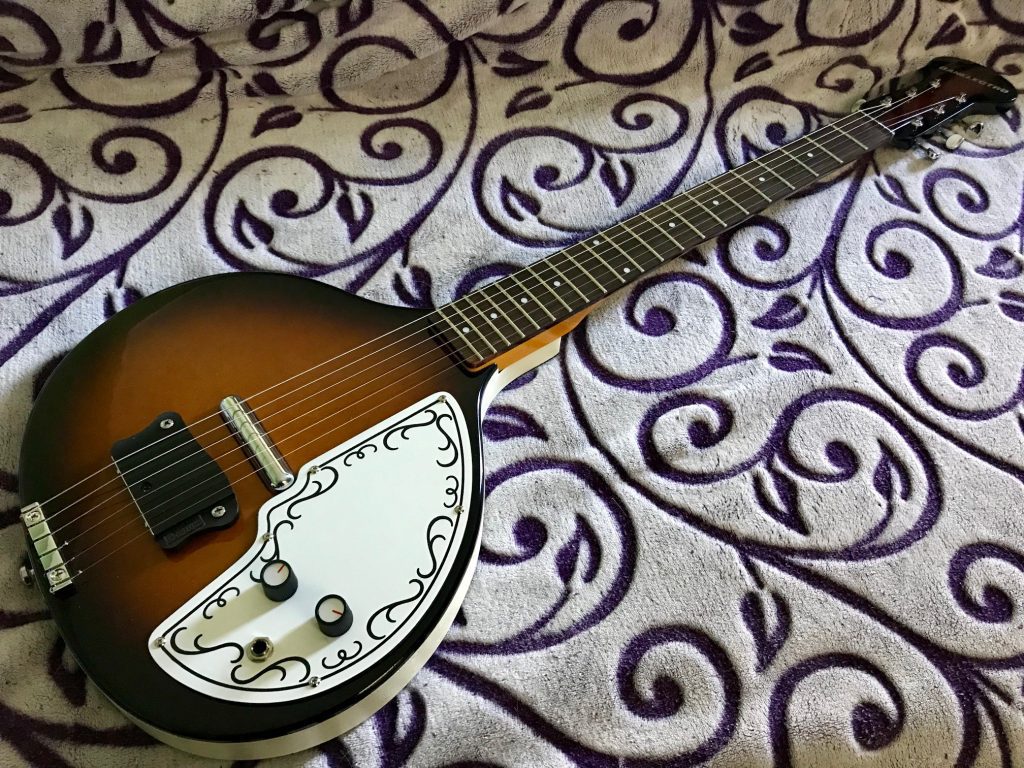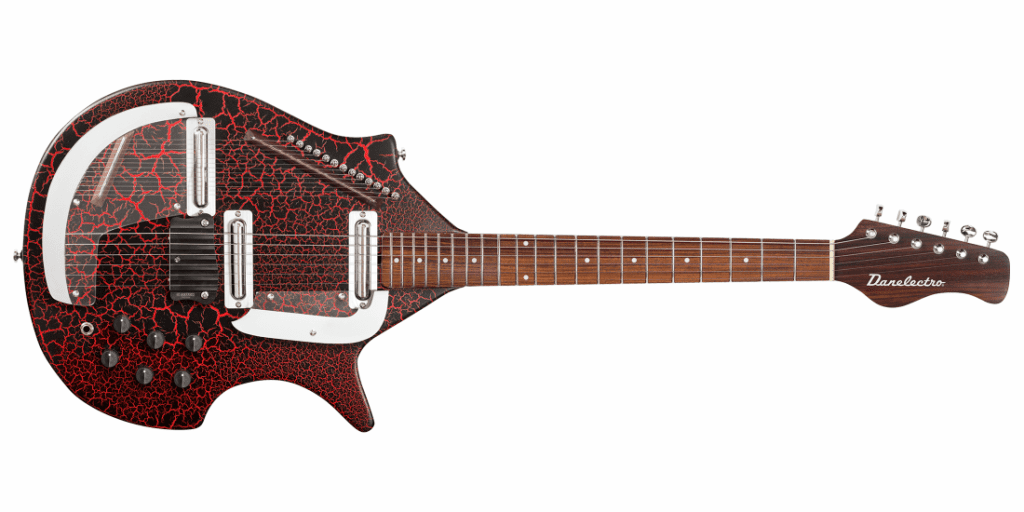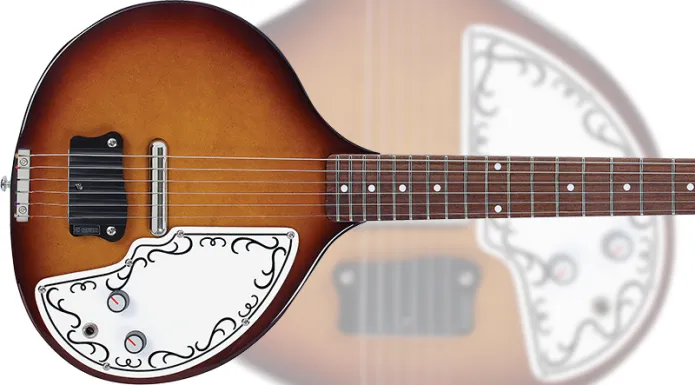The Danelectro Sitar is a unique instrument that combines elements of the traditional sitar with modern design and construction. It was first introduced in the 1960s by the American company Danelectro, and quickly gained popularity among musicians looking for a new and innovative sound. In this article, we will explore the history and background of the Danelectro Sitar, as well as its design, sound, playing techniques, and role in Indian classical music. We will also compare it to the traditional sitar and discuss its versatility, maintenance, and future potential.
The Design and Build of Danelectro Sitar
The Danelectro Sitar features a distinctive design that sets it apart from traditional sitars. It has a solid body made of Masonite or plywood, with a hollow chamber inside to enhance resonance. The neck is made of maple or poplar, and is typically shorter and narrower than that of a traditional sitar. The fretboard is made of rosewood or maple, and features metal frets instead of the movable frets found on a traditional sitar.
One of the most notable features of the Danelectro Sitar is its unique bridge design. It has six individual strings that pass over a series of metal rods, which are then pressed against the strings by a set of levers. This creates a buzzing sound similar to that produced by the sympathetic strings on a traditional sitar. The instrument also has a set of sympathetic strings that run underneath the main strings, adding to its unique sound.
Understanding the Unique Sound of Danelectro Sitar

The Danelectro Sitar produces a distinct sound that is reminiscent of the traditional sitar but with its own unique character. It has a bright and twangy tone, thanks to its solid body construction and metal bridge design. The buzzing effect created by the levers on the bridge adds to the overall sound, giving it a unique and exotic quality.
Compared to a traditional sitar, the Danelectro Sitar has a more focused and direct sound. The solid body construction and shorter neck length contribute to this difference in sound. Additionally, the use of metal frets instead of movable frets allows for more precise intonation and easier playing.
Several factors contribute to the unique sound of the Danelectro Sitar. The materials used in its construction, such as Masonite or plywood for the body and maple or poplar for the neck, play a role in shaping its tone. The metal bridge and levers also contribute to the buzzing effect and overall sound. Additionally, the use of sympathetic strings adds depth and resonance to the instrument’s sound.
Playing Techniques for Danelectro Sitar
Playing the Danelectro Sitar requires a different approach compared to playing a traditional sitar. Here are some tips and tricks to help you get started:
- Hand positioning: Unlike a traditional sitar, which requires complex hand positions and techniques, the Danelectro Sitar can be played with a more traditional guitar-style hand position. This makes it easier for guitarists to transition to playing the instrument.
- Picking technique: The Danelectro Sitar can be played with a pick or with fingers. Experiment with different picking techniques to find the one that produces the desired sound.
- Vibrato: The Danelectro Sitar is capable of producing a wide range of vibrato effects. Experiment with different finger movements and pressure to achieve the desired vibrato effect.
- Bending strings: The Danelectro Sitar allows for bending strings, which can add expressiveness to your playing. Experiment with bending techniques to add depth and emotion to your performance.
- Sliding: Sliding between notes is another technique that can be used on the Danelectro Sitar to create unique and expressive sounds. Experiment with different slide techniques to find the ones that work best for you.
It’s important to note that playing the Danelectro Sitar requires practice and experimentation. Don’t be afraid to try new techniques and explore the instrument’s capabilities.
The Role of Danelectro Sitar in Indian Classical Music
The Danelectro Sitar has found a place in Indian classical music, although it is not as widely used as the traditional sitar. It is often used by musicians who are looking for a different sound or who want to experiment with new styles and genres.
In terms of role and function, the Danelectro Sitar can be used in a similar way to the traditional sitar. It can be played as a solo instrument, accompanying vocals or other instruments, or as part of an ensemble. Its unique sound adds a distinct flavor to Indian classical music, allowing musicians to explore new sonic possibilities.
Some famous musicians who have used the Danelectro Sitar in their music include Ravi Shankar, Anoushka Shankar, and Nitin Sawhney. These musicians have embraced the instrument’s unique sound and incorporated it into their compositions, adding a modern twist to traditional Indian classical music.
Comparing Danelectro Sitar with Traditional Sitar
When deciding between the Danelectro Sitar and the traditional sitar, there are several factors to consider. Here are some pros and cons of using the Danelectro Sitar compared to the traditional sitar:
Pros of using the Danelectro Sitar:
- Easier to play: The Danelectro Sitar has a more familiar guitar-like neck and fretboard, making it easier for guitarists to transition to playing the instrument.
- More affordable: The Danelectro Sitar is generally more affordable than a traditional sitar, making it accessible to a wider range of musicians.
- Unique sound: The Danelectro Sitar has a distinct sound that sets it apart from the traditional sitar, allowing musicians to explore new sonic possibilities.
Cons of using the Danelectro Sitar:
- Limited traditional sitar techniques: The Danelectro Sitar does not have movable frets or sympathetic strings, limiting the range of traditional sitar techniques that can be performed on the instrument.
- Different sound: While the Danelectro Sitar has a unique sound, it may not be able to replicate the exact sound of a traditional sitar. This may be a drawback for musicians looking for an authentic sitar sound.
- Maintenance: The Danelectro Sitar requires regular maintenance to keep it in good condition. This includes cleaning, string changes, and adjustments to the bridge and levers.
When choosing between the Danelectro Sitar and the traditional sitar, it’s important to consider your musical goals, playing style, and budget. Both instruments have their own unique qualities and can be used to create beautiful music.
Exploring the Versatility of Danelectro Sitar
The Danelectro Sitar is a versatile instrument that can be used in a wide range of genres and musical styles. While it is often associated with Indian classical music, it has also been used in rock, jazz, fusion, and experimental music.
In terms of versatility, the Danelectro Sitar offers several advantages over the traditional sitar. Its solid body construction and shorter neck length make it easier to play and more suitable for different playing styles. It can be used as a lead instrument, accompanying vocals or other instruments, or as part of an ensemble.
However, it’s important to note that the Danelectro Sitar may not be suitable for all genres and musical styles. Its unique sound may not fit well in certain contexts, and its limitations compared to the traditional sitar may restrict its use in certain genres. It’s important to experiment and explore the instrument’s capabilities to determine its suitability for different musical styles.
Maintaining Danelectro Sitar
Proper maintenance is essential to keep your Danelectro Sitar in good condition and ensure optimal performance. Here are some dos and don’ts of maintaining the instrument:
Dos:
- Clean the instrument regularly using a soft cloth or guitar cleaning products.
- Change the strings regularly to maintain good tone and playability.
- Adjust the bridge and levers as needed to ensure proper intonation and buzzing effect.
- Store the instrument in a cool and dry place to prevent damage from humidity or temperature changes.
Don’ts:
- Use harsh chemicals or abrasive materials to clean the instrument, as this can damage the finish.
- Neglect regular maintenance, as this can lead to issues with playability and sound quality.
- Expose the instrument to extreme temperatures or humidity, as this can cause damage to the wood and other components.
If you encounter any issues with your Danelectro Sitar, such as buzzing strings, fret buzz, or tuning problems, it’s best to consult a professional luthier or guitar technician for assistance. They will be able to diagnose and address any issues with the instrument.
The Future of Danelectro Sitar

The Danelectro Sitar has seen several innovations and developments in recent years, with new models and designs being introduced. These innovations have focused on improving playability, sound quality, and durability of the instrument.
There is also potential for new uses and applications of the Danelectro Sitar in different musical genres and styles. As musicians continue to explore new sonic possibilities, the Danelectro Sitar offers a unique sound that can add depth and character to their compositions.
In terms of future trends, it is likely that we will see more musicians incorporating the Danelectro Sitar into their music, both in Indian classical music and other genres. As the instrument becomes more widely known and accessible, it will continue to gain popularity among musicians looking for a unique and innovative sound.
Conclusion: Is Danelectro Sitar Worth the Investment?
In conclusion, the Danelectro Sitar is a unique instrument that offers a distinct sound and playing experience. It combines elements of the traditional sitar with modern design and construction, making it easier to play and more affordable than a traditional sitar.
Whether or not the Danelectro Sitar is worth the investment depends on your musical goals, playing style, and budget. If you are looking for a unique sound and want to explore new sonic possibilities, the Danelectro Sitar may be a good choice. However, if you are looking for an authentic sitar sound or want to perform traditional sitar techniques, a traditional sitar may be a better option.
Ultimately, the decision to invest in a Danelectro Sitar should be based on your personal preferences and musical needs. It’s important to try out the instrument and see how it feels and sounds before making a decision.
